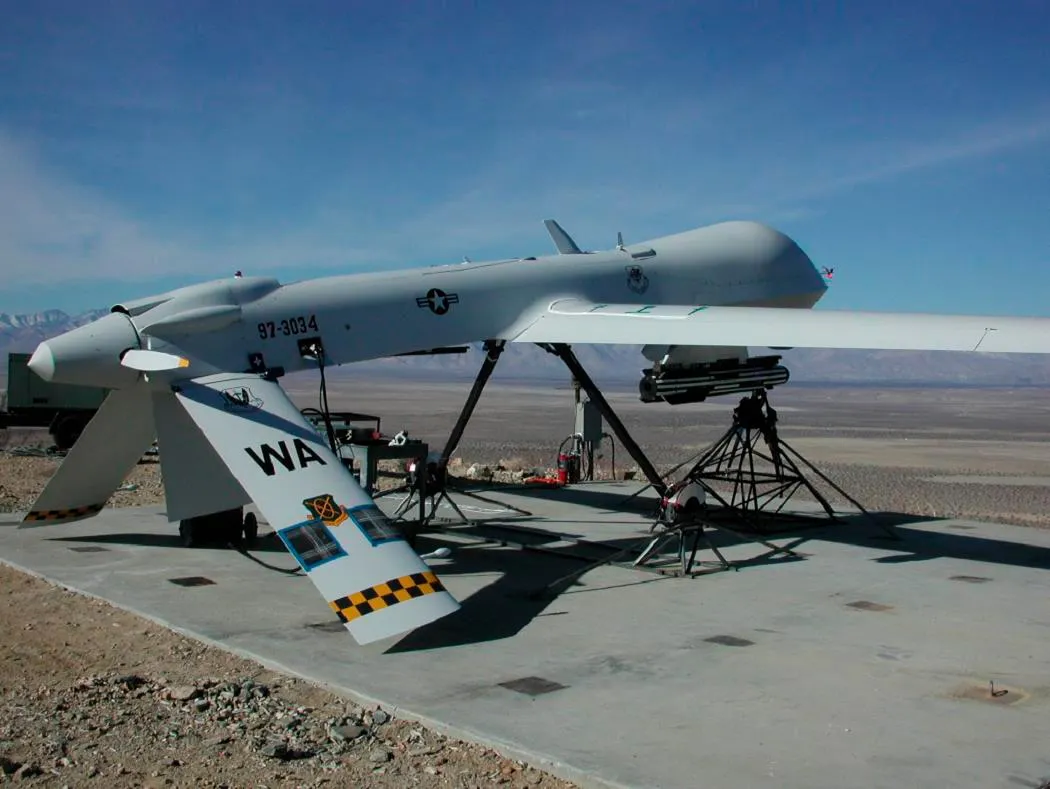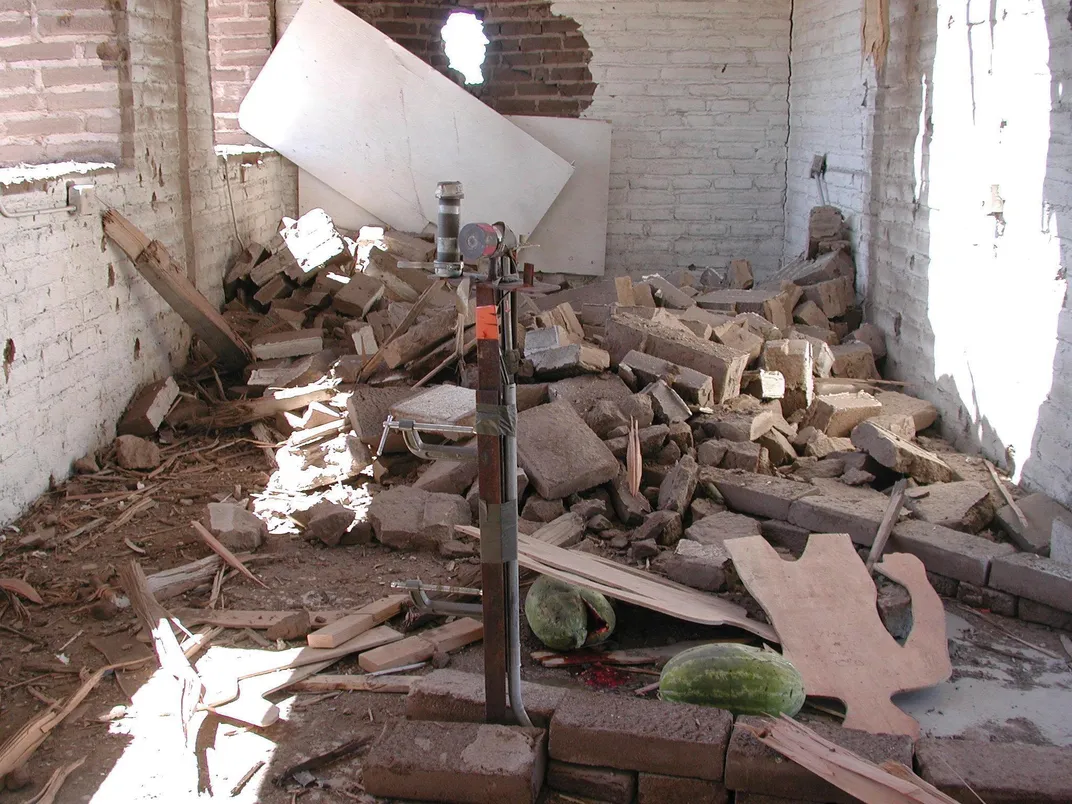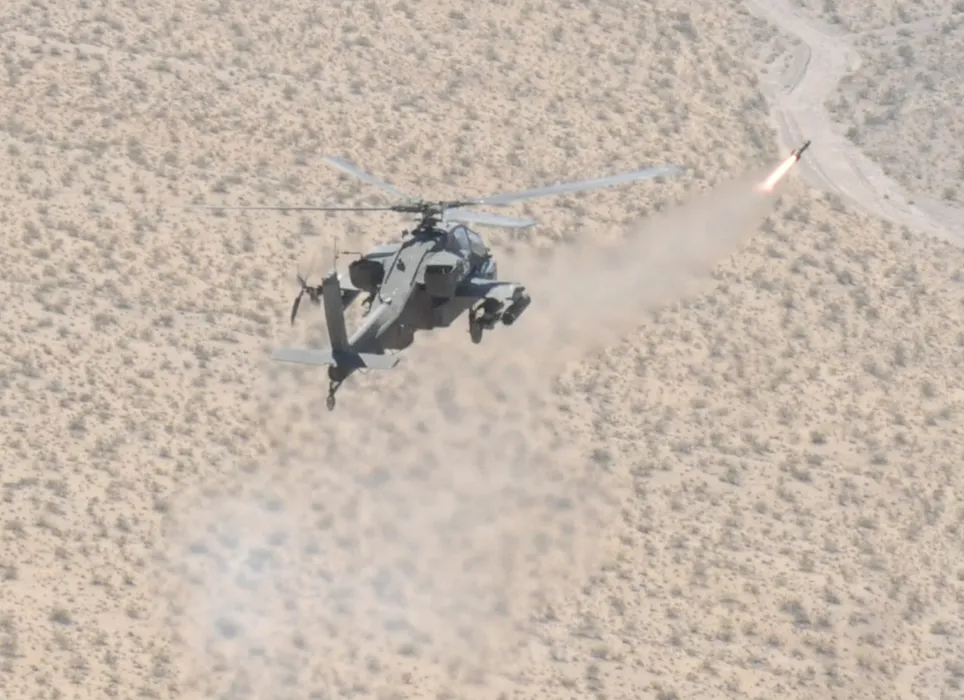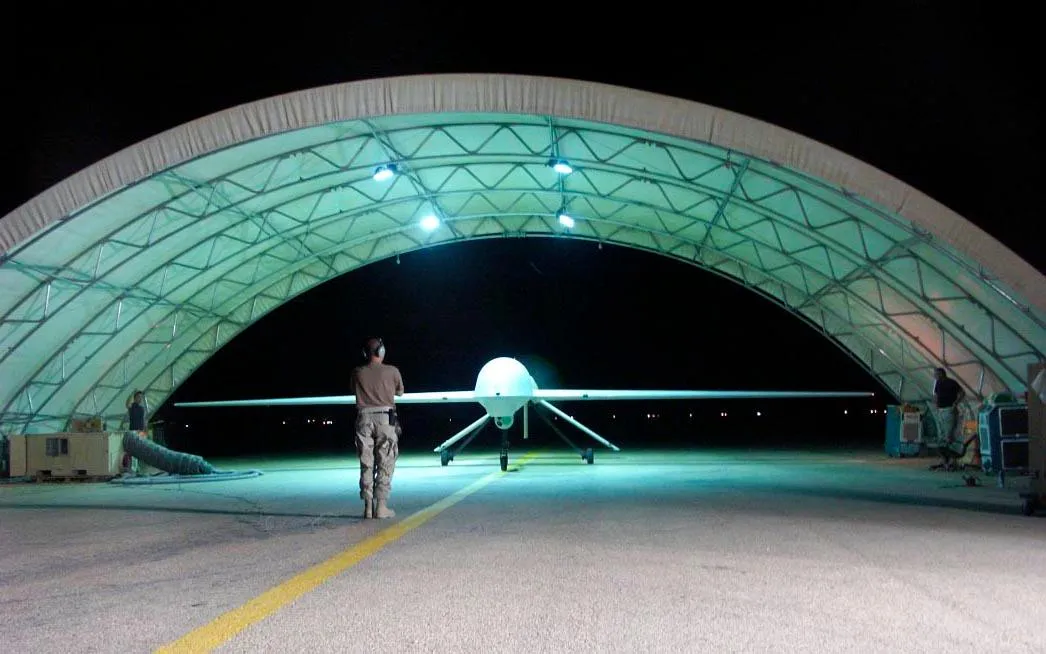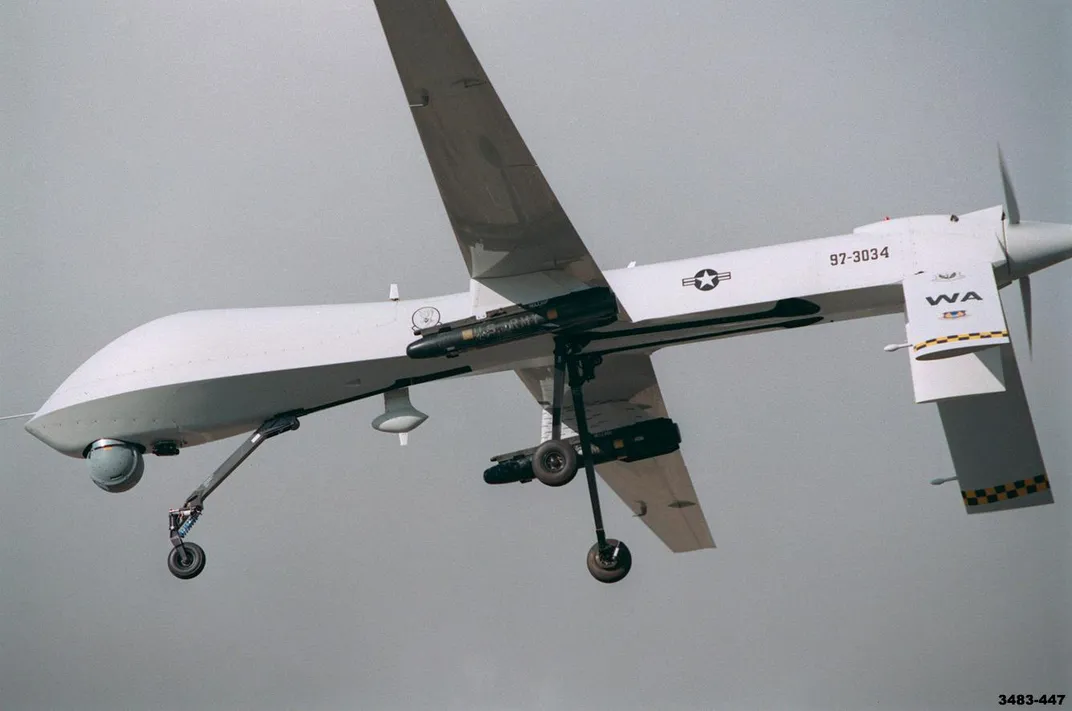Hellfire Meets Predator
How the drone was cleared to shoot.
/https://tf-cmsv2-smithsonianmag-media.s3.amazonaws.com/filer/61/81/61819ba7-453b-418a-9a4c-933a1d1660e6/29c_fm2015_hellfireafghanistana_live.jpg)
Contrary to later accounts, Air Force General John Jumper’s initiative to arm the Predator originally had nothing to do with the CIA’s covert operations against Osama bin Laden and Al Qaeda. Nor was Jumper’s project secret, though defense industry trade publications were the only media paying attention.
On May 1, 2000, when Jumper, chief of Air Combat Command, announced his intent to arm the 27-foot-long reconnaissance drone, using the unarmed version to look for Osama bin Laden was still no more than an idea the National Security Council’s Richard Clarke and the CIA’s Charlie Allen were urging on their reluctant bosses. Hardly anyone outside the military even knew what a Predator was, and many insiders were unimpressed by the fragile little reconnaissance drone, which in Bosnia had proved vulnerable to bad weather and relatively easy for the enemy to shoot down. The Air Force owned only 16 Predators at the time, and was planning to buy a total of only 48 Predators by the end of 2003.
In 1999, Jumper had directed the Air Force to experiment with putting laser designators on the drone; arming it was what he called “the next logical step.” For technical, legal, and cultural reasons, that step was a giant one. Since the Kettering Bug, World War I’s never-used “aerial torpedo,” the U.S. military had tried putting explosives or bombs or missiles on drones several times, but the results were never satisfactory. The closest brush with success came in the 1970s, when the Air Force and Teledyne Ryan put the TV-guided Maverick missile and later a TV-guided glide bomb on some Firebee target drones. By firing a Maverick from a modified Firebee on December 14, 1971, at Edwards Air Force Base in California, the Air Force’s 6514th Test Squadron claimed a place in aviation history: the first launch of an air-to-ground missile from a remotely piloted aircraft. None was put into operation, though, and with the end of U.S. involvement in Vietnam, Air Force interest in drones evaporated. The Navy, meanwhile, cancelled the most extensive armed UAV (unmanned aerial vehicle) program in U.S. history the same year the armed Firebee was tested, retiring its QH-50 DASH drone helicopter, which carried torpedoes and even nuclear depth bombs that were never used in combat.
Over the three decades since those experiments, the idea of weaponizing UAVs had been pursued by a number of people. But after 1987 the very legality of arming drones became questionable, at least for the United States and the Soviet Union. On December 8 of that year, President Ronald Reagan and Soviet leader Mikhail Gorbachev signed the Intermediate-Range Nuclear Forces Treaty, which required both nations to eliminate ground-launched ballistic and cruise missiles with ranges between 300 to 3,300 miles. Missiles launched from the sea or air were outside the pact, which defined a ground-launched cruise missile as “an unmanned, self-propelled vehicle that sustains flight through the use of aerodynamic lift over most of its flight path” and “a weapon-delivery vehicle.” The INF Treaty, as it is known, prompted Congress to give the Navy-run Unmanned Aerial Vehicle Joint Program Office authority solely over “nonlethal” drones.
In 1996, the INF Treaty between Washington and Moscow remained in force. The Predator’s success in Bosnia, however, was sparking new thinking about drones. For some, it was more exciting to imagine the technical possibilities than the possible legal limits.
No one was more excited about Jumper’s decision than Air Force Major General Michael C. Kostelnik, who saw it as an opportunity to advance his Small Smart Bomb. He wanted to run Jumper’s project, but Bill Grimes, the director of the shadowy Air Force technology shop known as Big Safari, thought it belonged to his outfit, which after all was the Predator’s official System Program Office. Lieutenant General Robert F. Raggio, a three-star that both Grimes and Kostelnik answered to, sided with Grimes. In early June 2000, Raggio told Kostelnik to stand down and directed Big Safari to figure out the smartest way to meet Jumper’s goal.
Grimes’ staff came up with three options. The Air Force, they found, owned no weapons light enough for a Predator to carry and had only two experimental ones in the works, the Small Smart Bomb and a lightweight, air-launched cruise missile that was still just a concept. The Army, however, had a missile that Big Safari thought showed promise. It weighed a mere 98 pounds but packed enough punch to kill a tank. Army helicopters had first fired it in combat nine years earlier, during the 1991 Gulf War, so it was proven. The Army had more than 11,000 in stock, and the Navy and Marine Corps had some too. Best of all, this Army missile was a “smart” weapon; it homed in on its targets by seeking the sparkle of a laser designator. The missile’s official designation was AGM-114, with AGM standing for “antitank guided missile.” Its official name was Heliborne-Launched Fire-and-Forget Missile. But to those familiar with it, the missile was known by an acronym describing what it delivered—-Hellfire.
On June 21, Jumper got a briefing from Colonel Robert E. Dehnert Jr., director of reconnaissance programs for the Aeronautical Systems Center at Wright-Patterson Air Force Base in Dayton, on the three options Big Safari had come up with. The two Air Force weapons that might work, Jumper was told, would not be available in useful quantities for several years. The Army’s Hellfire was available immediately and could be integrated with the Predator—made to fit under the drone’s wing and be launched from it—for as little as $485,000, a pittance to the Pentagon. The one major technical risk was that no one knew how launching a Hellfire would affect the aerodynamically delicate Predator.
There were legal hurdles to the project, no matter what weapon Jumper chose, including the 1987 INF Treaty, which was still in effect. A committee of government lawyers would have to decide whether an armed Predator fit the INF Treaty’s definition of a ground-launched cruise missile. If it did, Jumper’s “next logical step” could be a violation of a major international agreement.
At the conclusion of Dehnert’s briefing, Jumper directed his staff to work with Big Safari to come up with a detailed plan for arming the Predator with the Hellfire.
Just over three weeks later, on July 14, Dehnert returned to Jumper’s headquarters. The conference room was packed with more than 40 Air Force officers, senior enlisted experts, and officials and engineers from General Atomics and other companies. Standing beside a screen at one end of the conference room, Dehnert went through a series of slides that outlined two possible plans for arming the Predator with the Hellfire.
“The immediate objective is to fire a Hellfire missile from a Predator and hit something,” one of the first slides said. The first option Dehnert described would take nine months, cost an estimated $1.3 million, and offer “medium technical risk.” The second option was a 12-week “Accelerated Demo” expected to cost $1.5 million and disrupt all other Predator projects. This quicker option would also come with “high technical risk,” for it would be done the Big Safari way: with the least possible government regulation and paperwork.
As a result of the meeting, Jumper said that Big Safari would get $3 million to arm the Predator with the Hellfire—about double the cost of either option Dehnert had outlined, and $200,000 more than the two combined. Jumper also directed Big Safari to execute both the accelerated demonstration and the more cautious one.
***
Marrying the Hellfire to the Predator was no simple matter. A week after getting Jumper’s order, Big Safari director Grimes hosted a meeting at his headquarters in Dayton to discuss technical and other issues with representatives from the Hellfire program office at the Army’s Redstone Arsenal, engineers from General Atomics and other companies, and various Air Force experts.
“My first question is: Can I fire your missile off Predator without knocking it out of the sky?” Grimes asked the Army contingent.
No one was entirely sure. Whether the thrust from the Hellfire’s launch would throw the Predator into a spin when fired, or whether the missile’s plume—1,050 degrees Fahrenheit at its hottest—would damage the aircraft’s composite wings, tail, or fuselage, were questions that required engineering analysis, the team decided.
General Atomics already knew the wings needed to be beefed up to withstand the strain of carrying missiles. Hardpoints in the current wings could carry payloads of up to 100 pounds, but each Hellfire would need a launcher—a metal rack with a rail to carry and fire it from—and electrical equipment to make the launcher function. The Army experts said their Hellfire launchers were in short supply, so Big Safari might have to borrow a couple from the Navy and modify them to carry only one instead of the usual four missiles per launcher used by helicopters. The engineering team would also have to find a way to reduce the thrust needed to trigger a release spring on the rail whose function was to hold a missile in place until fired. The spring’s standard 600 pounds of resistance would have to be cut to about 235 pounds, or else a launch might rip the wing right off the aircraft.
The Hellfire’s software would have to be modified too, to launch the missile properly from the Predator’s normal operating altitude of about 15,000 feet, for the AGM-114 was designed to be launched at tanks by helicopters flying 2,000 feet or less above the ground. Test firings—first from the ground, then in the air—would be necessary.
Beyond all that, the engineers would have to integrate the missile’s circuitry and software with the Predator’s flight control computer and a new sensor turret, or modified Kosovo ball, which Raytheon Corporation was developing. The new turret would add the daylight camera lacking in the laser ball used in Kosovo.
On July 28, Big Safari received formal approval from Headquarters Air Force to do what Jumper wanted, but the instruction said no Predators were to be modified until the service got both Congressional approval and a ruling that arming the drone was acceptable under the INF Treaty. Under the circumstances, the Big Safari team did as much analysis and made as many modifications as they could.
Engineers at Wright-Patterson analyzed the Hellfire’s rocket plume and came up with encouraging results. Because the Hellfire would get away from the Predator so fast—within 250 milliseconds it would be 16 feet past the drone’s nose—and its rocket plume was so compact, the aircraft’s tail would only “see” (in engineering jargon) a high temperature of 440 degrees Fahrenheit as the missile departed, and that only briefly. The wing and fuselage would see only 170 degrees, and the air pressure change around the plume would present no problems.
General Atomics, meanwhile, conducted analyses showing that a Hellfire could indeed be launched from a Predator without breaking the aircraft apart or throwing it into a spin.
Engineers at the General Atomics factory in California began writing the software needed to wed the Hellfire to the Predator. They also designed new ribs and cross brackets to go inside the Predator’s wings at their hardpoints, allowing them to carry a single-rail launcher derived from a multi-rail launcher that Big Safari had quickly gotten from the Navy. The engineers were still barred, though, from making any changes to the aircraft chosen to become the first armed Predator, tail no. 97-3034.
On August 30, Air Force lawyers issued a legal opinion forbidding all “touch labor” to arm the Predator prior to getting approval from Congress. Now the team working on Jumper’s project was barred from modifying not only Predator 3034 but also any of the other equipment needed for the project. All they could do was look and analyze, not act.
***
Parked on the concrete floor of a hangar at General Atomics’ flight test facility at El Mirage, California, the rubber wheels of its three-legged landing gear locked in bright yellow chocks, was Predator 3034. A dozen feet to either side, sitting atop aluminum wing stands—trestles akin to sawhorses—were the Predator’s unattached wings.
Midway along the underside of one wing hung a single rail cut from what once was a four-rail M299 Hellfire launcher. Hung from the rail was a black Hellfire. The missile was what Big Safari called a House Mouse. Not only did this Hellfire carry no propellant to create thrust and make it fly, it also lacked the shaped explosive charge a live missile would carry, a charge that could generate a jet of heat and pressure powerful enough to drill through a heavy tank’s armor on impact. The mock Hellfire, however, held all the same electronics as a live one. Running from the launcher where the House Mouse hung on the unattached wing to the socket where the wing was meant to fit into Predator 3034’s fuselage was a collection of gray wires.
This unorthodox sight had resulted from a phone call received by the Big Safari office at General Atomics on September 21. The Air Force had secured Congressional approval to spend money arming the Predator, so touch labor would now be allowed. But the state department general counsel’s “initial opinion,” as a senior Air Force procurement officer reported in an email to Jumper and others, was that a “weaponized Predator constitutes a cruise missile, hence an INF Treaty problem.” Lieutenant General Stephen Plummer added that the defense department’s general counsel was “working with them to change that opinion.” But until the issue was resolved, no missile could be mounted on a flyable Predator.
Big Safari’s solution, meanwhile, was to put the missile launcher on a detached wing and then wire it to the flight control computer in the Predator’s fuselage to check whether the systems would work together once the wing was reinstalled. The tactic was legal, for a Predator unable to fly was clearly outside the INF Treaty definition of a cruise missile as “an unmanned, self-propelled vehicle that sustains flight.”
On January 2, Predator 3034 got its wings back in the General Atomics hangar at El Mirage. Government treaty experts had decided that a lethal drone was permissible under the INF Treaty, according to the simple logic that a cruise missile, by definition, had a warhead, and the Predator didn’t. The Predator was merely a platform, a UAV that had landing gear and was designed to return to base after a mission.
At El Mirage, each of 3034’s wings held a single gray launch rail, and each rail angled down five degrees from its wing’s leading edge. With the wings in place, a small group of engineers and technicians fitted the drone with a Forty-Four ball, the same laser designator turret used on the Predators flown over Kosovo in 1999. Then, after three weeks of ground and test flights of various kinds, the team trucked 3034, a ground control station, and other equipment 90 miles north to the test range at China Lake Naval Air Weapons Station to start shooting missiles.
***
Now Predator 3034 had its wings and nose, but its tires were missing. At China Lake, it would be put through a static ground launch of a Hellfire to see, before trying it in the air, what a missile rocketing off the drone’s wing would do to the aircraft. Under each of 3034’s shiny new white wings hung a 64-inch-long inert Hellfire.
Only one of these inert Hellfires would be launched in the test, but each had white stripes along its black skin, the better to help high-speed film and video cameras see the missile’s aerodynamics in flight. The stresses on the drone from the heat and thrust of the Hellfire’s rocket plume would be measured by thermal, strain, and pressure gauges, and by temperature-indicating crayons applied to the laser ball, tails, and leading edges of the wings.
Chained to its test pad, 3034 sat with its nose pointed northwest and nine degrees upward. Behind the drone and its Hellfires was a hill 40 feet higher, with two big antennas on its summit, one to stream the Predator’s video, the other to communicate with a ground-based laser designator sitting beside a control van a couple of miles downrange. A crew manning the second laser designator would shine a laser beam to guide the inert Hellfire to a mock target, a dusty, defunct green tank sitting in the desert three miles straight ahead of the Predator.
Shielded from the test pad by the hill holding the antennas was a concrete bunker full of test gear and engineers, including General Atomics project manager Christopher Dusseault and Major “Spoon” Mattoon, a weapons testing expert and Big Safari’s project manager. Behind the bunker sat the Predator’s ground control station.
At 10:39 a.m., with the Predator’s engine running and its small pusher propeller gently turning, Mattoon decided it was time to launch a missile.
After a split-second pause, a jet of flame as long as the missile spurted from the rear of the Hellfire under the Predator’s right wing. In the flight’s first two and a half seconds, the missile reached Mach 1.3, then slowed to about 400 mph. The Hellfire slammed into the side of the target tank’s turret, right where a nearby camera showed the beam’s sparkle flickering. The aluminum test missile burst into ragged black chunks.
The Predator team spent the rest of the day analyzing video of the Hellfire launch and the missile smashing into the right side of the tank, studying the test from every angle and at actual speed, in slow motion, and in superslow motion. Now the question was whether the Predator could repeat its new trick in flight.
***
On Friday, February 16, 2001, Air Force Captain Curt Hawes would make aviation history, becoming the first person ever to launch a Hellfire missile from a Predator in flight.
Certain the test would be covered by CNN, Hawes told his parents back in Minnesota to watch for him. The first Hellfire launch from a Predator in flight would indeed be historic, and the test was no secret. The Air Force and General Atomics would issue news releases about it, prompting Inside the Air Force and the Las Vegas Review-Journal to write articles about the project. As it turned out, however, the event was of far less interest to CNN than to the CIA and the NSC.
Curt Hawes and most others on the test team were oblivious to the intelligence agencies’ interest in what they were doing. Big Safari’s Hellfire test director Mattoon, however, knew who the armed Predator’s first customer was likely to be.
***
As the test flight briefing ended, Hawes stood up and faced the crew. “We have come too far and all worked too hard for this to be anything but successful,” he declared. “Let’s go out and kick some ass!”
A few minutes later, a contractor crew using a ground control station at Indian Springs, Nevada, launched 3034 and flew the Predator northeast into the vast test and exercise ranges of Nellis Air Force Base in Nevada. After the drone was beyond some hills that made C-band line-of-sight control impossible, Hawes and sensor operator Leo Glovka took control of 3034 from a second ground control station parked on the Nellis test range, also using a C-band antenna. Under the crawl-walk-run philosophy of testing, the first Hellfires would be launched with the Predator under line-of-sight control, thus avoiding the risk of losing a link to the drone when flying via satellite. With 3034 carrying an inert Hellfire fitted with sensors to gather and transmit data in flight, Hawes did some dry runs toward the target, an old tank parked in the desert. Glovka would go through the motions of a launch, putting the crosshairs of the Forty-Four ball’s heat-detecting infrared sensor on the tank. To reduce the chances of a miss, a ground-based laser designator team would shine the beam used to guide the Hellfire to its target.
Hawes used the nose camera to line the Predator up on the tank at an altitude of 2,000 feet, then flew the drone toward the “engagement zone.” Once 3034 entered the zone, Hawes depressed and held the black launch button on the throttle with his left thumb, then squeezed the trigger on the front of the joystick with his right forefinger. With a flash of heat and light, the Hellfire rocketed off the drone’s left wing and instantly disappeared.
The unarmed missile traveled three miles downrange and struck the tank about six inches to the right of dead center. Best of all, as instruments aboard the drone showed, the Predator barely shook.
After the test, Hawes was struck by how anticlimactic the experience was. From the earthbound cockpit he was using to fly the Predator, he heard and felt nothing as the Hellfire left the wing and completed its flight in less than 30 seconds. The shot Hawes had anticipated for weeks seemed to be over almost before it began.
Five days later, the team repeated the performance twice. Both Hellfire shots hit the target.
On September 11, 2001, less than one hour after Al Qaeda hijackers slammed an American Airlines plane into the World Trade Center, Lieutenant General Donald Cook, acting commander of Air Combat Command at Langley Air Force Base in Virginia, received a telephone call. The White House wanted to know how soon the Air Force could get three Predators over Afghanistan—with missiles under their wings.
